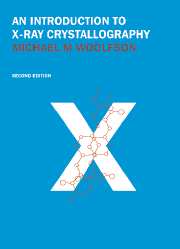Book contents
- Frontmatter
- Contents
- Preface to the First Edition
- Preface to the Second Edition
- 1 The geometry of the crystalline state
- 2 The scattering of X-rays
- 3 Diffraction from a crystal
- 4 The Fourier transform
- 5 Experimental collection of diffraction data
- 6 The factors affecting X-ray intensities
- 7 The determination of space groups
- 8 The determination of crystal structures
- 9 Accuracy and refinement processes
- Physical constants and tables
- Appendices
- Solutions to Problems
- References
- Bibliography
- Index
8 - The determination of crystal structures
Published online by Cambridge University Press: 11 January 2010
- Frontmatter
- Contents
- Preface to the First Edition
- Preface to the Second Edition
- 1 The geometry of the crystalline state
- 2 The scattering of X-rays
- 3 Diffraction from a crystal
- 4 The Fourier transform
- 5 Experimental collection of diffraction data
- 6 The factors affecting X-ray intensities
- 7 The determination of space groups
- 8 The determination of crystal structures
- 9 Accuracy and refinement processes
- Physical constants and tables
- Appendices
- Solutions to Problems
- References
- Bibliography
- Index
Summary
Trial-and-error methods
The object of a crystal-structure determination is to locate the atomic positions within the unit cell and thus completely to define the whole structure. Sometimes there are special features in the diffraction pattern, the space group or the suspected chemical configuration of the material under investigation which enable a guess to be made of the crystal structure or at least restrict it to a small number of possibilities. In the early days of the subject, when methods of structure determination were poorly developed, only the simpler types of structure could be tackled and trial-and-error methods based on such special features were commonly used. That is not to say that such techniques are now outmoded – no crystallographer would ignore the information from special features if it was available, but he does not rely on such information as much as hitherto.
One type of situation which is of great importance and is always sought by the crystallographer is when space-group considerations lead to the fixing or restricting of the positions of atoms or whole groups of atoms. If a centrosymmetric unit cell has only one atom of a particular species (or an odd number) then that atom (or one of them) must be at a centre of symmetry. In a case with an odd number of atoms in a cell with a diad axis one of the atoms would have to lie on the diad axis. Similarly, in some situations, an SO4 group may have to be symmetrically arranged on a triad axis as shown in fig. 8.1.
- Type
- Chapter
- Information
- An Introduction to X-ray Crystallography , pp. 231 - 300Publisher: Cambridge University PressPrint publication year: 1997

